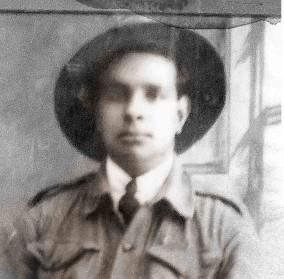World War 1, South-West Asia, Turkiye, Gallipoli,Anzac Cove, 621 FARMER, 28 Battalion, 1915
Photograph of 621 Private Larry Farmer of Ballaying, killed in action 4-6 August 1916. at Pozieres.
Larry Farmer, who was also known as ‘Pincher’, was born in Katanning, Western Australia in March 1894. He was the third of eight sons born to William Pegg Farmer and Emily Coyne who were of Aboriginal descent. Larry was raised and educated in Katanning where he gained a reputation as a talented footballer, winning a gold medal in the 1911 football season. When he enlisted in Australian Imperial Force (AIF) on 13 March 1915 in Bridgetown, some 140 kilometres south west of his birthplace, Larry had been working in the timber industry and described himself as a labourerFollowing a period of training at Blackboy Hill, Larry joined the 28th Battalion on 16 April 1915. Along with his fellow troopers, Larry embarked from Fremantle on 9 June aboard the HMAT Ascanius A11 bound for Egypt.
. On 4 September, Larry embarked aboard SS Ivernia from Alexandria and arrived at Gallipoli four days later. Over the next three months, in addition to losing men during the fighting, the Battalion lost more than one third of its troops from sickness including typhoid, jaundice, pneumonia and rheumatism. Following rest and reorganisation after the Allied evacuation of Gallipoli in December 1915, Larry sailed for Marseille in France with the 28th Battalion, arriving on 16 March. While engaged in the Battle of Pozieres, Larry Farmer was killed in action.
Details
Details
Pozières was a high point on the battlefield which gave it strategic significance. Mouquet Farm was in a valley below PozièresThree Australian divisions fought at Pozières and Mouquet Farm from 23 July until 3 September when they were relieved. During this period, the Australians had 23,000 casualties. War historian Charles Bean said of the windmill site at Pozières that “no place is more thickly drenched in Australian blood than that tiny and apparently insignificant pocket of land.”
The service of 13 Diggers, now honoured as Aboriginal, original ANZACs, who served with the Australian Imperial Force in Gallipoli are commemorated by name in dioramas in the World War 1 Gallery at the Australian Army Museum of Western Australia.
Open in Google Maps
Nearest geotagged records:
- World War 1, Australia, Western Australia, 3366 NEWMAN, 10 Light Horse (0km away)
- World War 1, Australia, Western Australia, 1739 GEORGE, 10 Light Horse (0km away)
- World War 1, Australia, Western Australia, 2934 HANNA, 10 Light Horse (0km away)
- World War 1, Australia, Western Australia, 1271 RING, 10 Light Horse (0km away)
- World War 1, Australia, Western Australia, 2418 WEIDENBACH, 10 Light Horse (0km away)
- World War 1, Australia, Western Australia, MASON, 10 Light Horse (0km away)
- World War 1, Australia, Western Australia, 1441 SOLLY, 10 Light Horse (0km away)
- World War 1, 30 FITZMAURICE, 10 Light Horse (0km away)
- World War 1, Australia, Western Australia, Katanning, 179 AINSWORTH, 10 Light Horse (0km away)
- World War 1, Australia, Western Australia, 202 KEAY, 10 Light Horse (0km away)
Nearby places: View all geotagged records »
Australian Army Museum of Western Australia
Australian Army Museum of Western Australia
Other items from Australian Army Museum of Western Australia
- World war 1, South-West Asia, Turkiye, Gallipoli, Anzac Cove,421 FARMER, 28 Battalion, 1915
- World War 1, South-West Asia, Turkiye, Gallipoli, Anzac Cove. 307 HUTCHINS. 28 Battalion, 1915
- World War 1, South-West Asia, Turkiye, Gallipoli, Anzac Cove, 1952 JACKSON, 28 Battalion, 1915
- World War 1, South-West Asia, Turkiye, Gallipoli, Anzac Cove,1123 LOCKYER, 1915
- World War 1, South-West Asia, Turkiye, Gallipoli, Anzac Cove, 897 MASON, 28 Battalion, 1915
- Medal - Queen Elizabeth II Golden Jubilee Medal
- World War 1, South-West Asia, Turkiye, Gallipoli, Anzac Cove, 2515 MELBOURNE, 5 Battalion, 1915
- World War 1, South-West Asia, Turkiye, Gallipoli, Anzac Cove, 1310 NALEY, 16 Battalion, 1915
- Medal - Meritorious Service Medal (1916-1918) Gallantry and Immediate
- World War 1, South-West Asia, Turkiye, Gallipoli, Anzac Cove, 2413 SHAW, 52 Battalion, 1915
- World War 1, South-West Asia, Turkiye, Gallipoli, Anzac Cove,165 McCALLUM, 16 Battalion, 1915
- World War 1, Western Australia, Perth heritage week Exhibit, 251 McDONALD GE, Hospital Transport Corps















